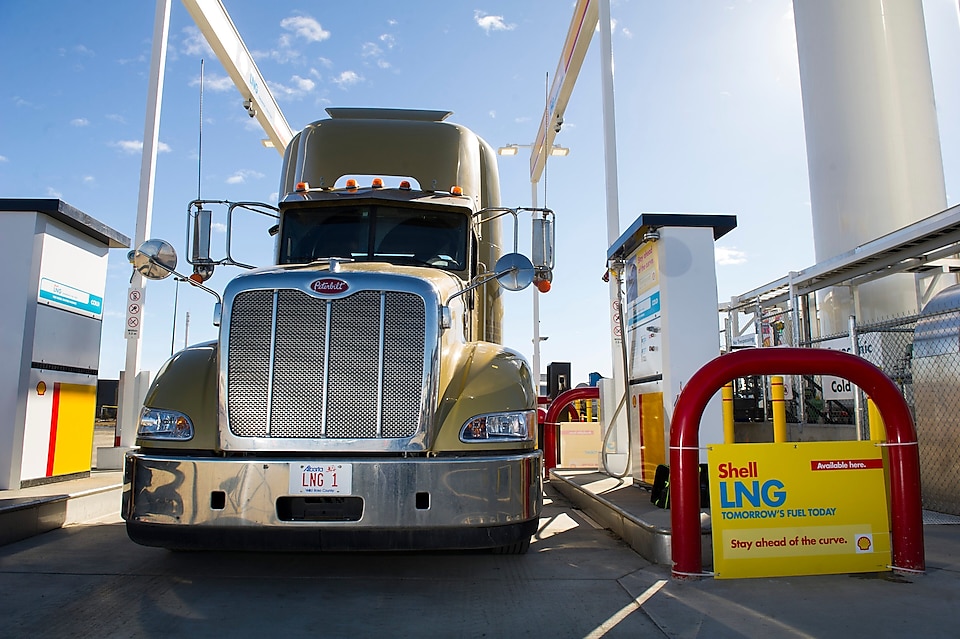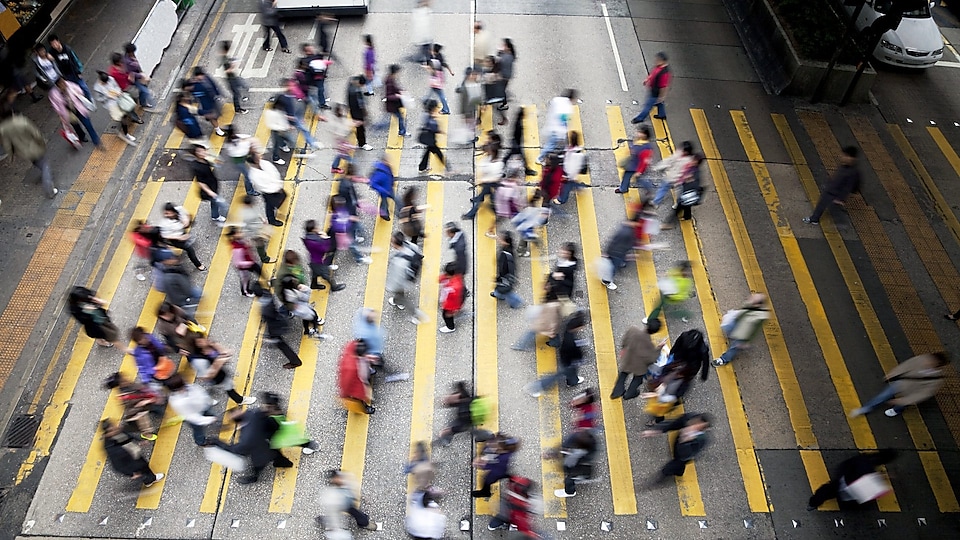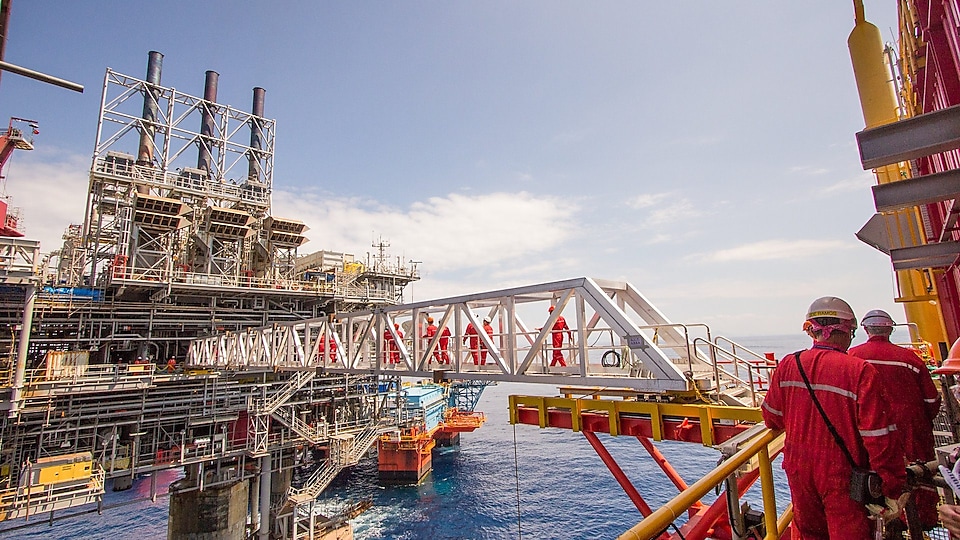
Natural gas
We are helping to meet growing global energy demand and limit CO2 emissions with cleaner-burning natural gas. It powers, heats and cools industries, homes and businesses, and it can be a good partner to renewable energy sources like wind and solar. Natural gas can also be used as a lower-carbon fuel for ships, trucks, buses and trains.
Global demand for natural gas, could rise by more than half by 2040, according to the International Energy Agency.
Natural gas is the cleanest-burning hydrocarbon. We explore for it, and produce it, on and offshore. It makes up more than half of our production today.
Advantages of natural gas
Natural gas is the cleanest-burning hydrocarbon, producing around half the carbon dioxide (CO2) and just one tenth of the air pollutants of coal when burnt to generate electricity.
It is abundant. If consumption remained at today’s levels, there would be enough recoverable gas resources to last around 230 years.
It is versatile. A gas-fired power station takes much less time to start and stop than a coal-fired plant. This flexibility makes natural gas a good partner to renewable energy sources like solar and wind power, which are only available when the sun shines and the wind blows.
Gas for Health
Title: Natural Gas for Health
Duration: 2:57 minutes
Description:
Villagers in Gujarat, now using piped gas in their homes, are impacting their health for the better by avoiding the many proven health dangers of exposure to smoke emissions from household solid fuels.
[Background music plays]
Dramatic instrumental music.
[Audio]
Crackling fire sounds.
[Video footage]
Footage of Ushaben placing wood into the fire pit in her home. Extreme close-up of Ushaben as she blows on the fire, sweat beading on her forehead, cutting to a close-up of a large pot of food simmering on the fire.
[Voiceover]
Ushaben spends three hours a day cooking for her family, like millions of women in rural India.
[Video footage]
More footage of Ushaben on her haunches, stoking the fire beneath the pot of food. Smoke rises up from the fire. Extreme close-ups of the log fire and Ushaben’s sweat-beaded face.
Interview with Ushaben
[Title]
Villager, Gujarat, India
[Text displays]
Ushaben
Villager / Gujarat, India
[Ushaben - subtitle]
We bring the wood and burn it in fireplace.
[Video footage]
Close-up in profile of Ushaben’s sweat-beaded face, cutting to a mid-shot of Ushaben facing the camera, the rough brick walls of her home in the background.
[Ushaben - subtitle]
Due to the smoke, both me and the children cough. We sweat and our eyes start to tear. This is the harm it causes our bodies.
[Video footage]
Low angle close-up in profile of a small boy against the background of the home’s tin roof, reaching up to Ushaben who is out of shot. This dissolves to footage of smoke billowing up towards the roof.
[Audio]
Child coughing.
[Video footage]
Rear-view close-up of the child coughing, cutting to a low-angle footage of Ushaben caressing his head, as he wipes his eyes with her clothing. Mid-shot of Ushaben facing the camera, the rough brick walls of her home in the background. Footage of Ushaben and the child seated on the floor of the home as smoke billows from the fire.
[Background music plays]
Instrumental music with strings.
[Voiceover]
Air pollution is the world’s single largest environmental health risk.
[Text Displays]
In India, more than 50 percent of the population still rely on solid fuels
[Video footage]
Footage of smoke billowing from the top of a factory chimney, dissolving to a wide shot of an industrial area, with black smoke billowing from the factory chimney and across the skies just above the canopy of roofs. Low-angle footage of vehicles approaching on a busy road. The skyline in the background is filled with factory chimneys. Footage of street-side vendor carts, with bicycles passing in the foreground, cutting to a wide view of another busy street lined with multi-story buildings and filled with oncoming traffic and pedestrians. Footage of pedestrians walking the busy city streets, cutting to wide view of two women walking down a sidewalk, both carrying burdens on their head. The sidewalk is lined with laundry that has been hung out to dry. Low-angle view of a building where a number children are visible through the large window, but the windows are covered with burglar guards and mesh. Footage of residents entering and exiting two doorways respectively. The doors open right onto the street. An old cart, a motorcycle and laundry are visible outside the homes.
[Voiceover]
Here, at the local clinic, the majority of patients are women and children and most have respiratory issues.
[Video footage]
High angle view of people walking over the sidewalk towards the entrance of the local clinic. Footage from the doctor’s office, including a close-up of a patient’s face as she speaks, a high angle view of the patient seated across the desk from the doctor, and a close-up of the doctor as he speaks.
Interview with Dr. Manohar Ghemawat
[Text displays]
Dr. Manohar Ghemawat
Village Doctor / Gujarat, India
[Dr. Manohar Ghemawat]
Because of the wood burning stoves, there are diseases related to lungs like respiratory tract infection that may lead to… in an advanced state, to lung cancers.
[Video footage]
Low-angle close-up of Dr Ghemawat, against the background of his clinic office. Footage of the doctor taking the patient’s blood pressure, cutting back to the low-angle close-up of Dr Ghemawat as previously described.
[Dr. Manohar Ghemawat]
The second thing is the burning eye and early cataract.
[Video footage]
Footage of the doctor inspecting the patient’s eyes.
[Background music plays]
Instrumental music with strings.
[Voiceover]
Across the country, exposure to smoke emissions from household solid fuels is estimated to cause 500,000 deaths and 5 million illnesses annually, according to the WHO.
[Video footage]
Footage of a pink-hued sky, showing black smoke billowing up into the skies, dissolving to footage of Ushaben carrying the child on her hip and walking towards the entrance of her home. Extreme wide shot of an elderly woman exiting a doorway and crossing a courtyard. Footage of a busy sidewalk, motorbikes passing in the foreground, cutting to a woman seated next to a fire pit, using her clothing to shield her face from the smoke. More footage of a pink-hued sky filled with billowing black smoke.
[Background music plays]
Synthesised instrumental music with xylophone effect.
[Voiceover]
However, in some areas of Gujarat, the picture is quite different.
[Video footage]
Low-angle rear view of young people walking along a street, approaching residential buildings. Pan to close-up of Rameelaben, cutting to a footage of Rameelaben entering her neat kitchen and crossing to her gas stove, which she lights before placing a pot on the stove.
Interview with Rameelaben
[Text displays]
Rameelaben
Villager / Gujarat, India
[Rameelaben - subtitle]
Before, we had to search for wood and it would take 2 hours. Then we would go to work, come home, place the wood in the fireplace before we can start cooking, which takes another 1 to 2 hours. When we started using gas, we had extra time for work.
[Video footage]
Close-up of Rameelaben as she speaks. Footage of Rameelaben lifting a bundle of firewood onto another woman’s head, who then walks down the street, heading away. Close-up of Rameelaben as she speaks.
[Voiceover]
Using piped gas, women can save up to five hours every day, which also helps them increase their household income.
[Video footage]
Footage of Rameelaben turning on the gas valve, and pouring a handful of rice into the pot on the stove. Low-angle close-up of Rameelaben, cutting to a wide view of her standing at the stove.
[Rameelaben - subtitle]
With extra time at hand, we work as house help and earn 1500 rupees more per month.
[Video footage]
Close-up of Rameelaben as she speaks.
[Video footage]
Pale blue skies and a large tank forming the background.
Interview with Kartikeya Sarabhai
[Kartikeya Sarabhai]
Suppose gas was a little more expensive – it’s still better because you take the total benefit of it.
[Video footage]
Low-angle view of a line of power pylons and cables, foliage and green grass in the foreground. Low-angle footage of trucks passing below and then fully revealing a pylon standing tall against the blue sky, cables stretching out from it in either direction. Close-up of Kartikeya Sarabhai against a background of green foliage.
[Background music plays]
Instrumental music with piano and strings.
[Title]
Founder and Director, Centre for Environment Education
[Kartikeya Sarabhai]
I think people are now convinced that it’s good for them. It’s good for their health, their dignity, their working – and I think that’s very important and I think that’s where the government support is very useful.
[Video footage]
Footage of people on the streets of Gujarat, some seated, some walking alongside the traffic on the busy streets, some on motorcycles, others crossing the street as traffic races past. Close-up of Kartikeya Sarabhai against a background of green foliage. Footage of Rameelaben in her pink and blue-painted living room, seated across from a smiling young man with a child on his lap.
[Voiceover]
Gujarat is the first state to connect some of its villages to piped gas for cooking.
[Video footage]
More footage of Rameelaben’s family – close-ups of the smiling young man, of the child on his lap, of a young girl, and of Rameelaben.
[Voiceover]
An aspiration, according to the Prime Minister, is to expand this to several other states.
[Video footage]
More footage of the people of Gujarat – a teeming crowd of Indian pedestrians; two women walking down a street, chatting; and several young children seated together indoors, books on the laps of some.
[Voiceover]
Good news for India. Great news for the health of India’s women and children.
[Video footage]
Low-angle view of a boy walking down a street, a toddler on his shoulders, other children running alongside in the street. Close-up of the young boy previously seen in Ushaben’s home. Mid-shot of a smiling Ushaben facing the camera, the rough brick walls of her home in the background. Close-up of a smiling Rameelaben.
[Audio]
Shell jingle.
[End Logo]
Shell Pecten
[Text displays]
© Shell International Limited 2019
Liquefied natural gas (LNG)
We cool natural gas to -162° Celsius (-260° Fahrenheit), turning it into a liquid and reducing its volume by 600 times, which makes it easy and economical to ship to energy-hungry places around the world. We also turn LNG back into gas for distribution to homes and businesses.
As a pioneer of LNG, Shell provided the technology for the world’s first commercial LNG plant in 1964, and shipped the very first commercial cargo, starting a global trade. We have been designing and building LNG plants.
Learn more about LNG on our global website
Floating LNG (FLNG)
Traditionally, LNG plants are built on land. But Shell is building a giant floating facility to produce liquefied natural gas at sea, Prelude FLNG. It will also be the largest offshore floating facility ever built – 488 metres (1,600 feet) long and 74m (243ft) wide.
Shell has developed revolutionary technology that allows gas to be produced, liquefied, stored and offloaded into LNG carriers at sea. It allows clusters of smaller, remote fields to be unlocked by one FLNG facility, or larger fields to be served by several FLNG facilities.

LNG for transport
Natural gas could form a bigger part of the transport energy mix as a lower-carbon fuel, alongside developments in vehicle efficiency, biofuels, hydrogen and electric mobility.
We are exploring the use of LNG as a transport fuel for trucks and ships with potential economic and environmental benefits compared to diesel and fuel oil. Other uses include in trains, the mining sector and industrial applications. We are also looking at ways to use LNG more in our own operations.
Read more about LNG as a transport fuel on our global website
Gas-to-liquids (GTL)
Shell’s gas-to-liquids (GTL) technology converts natural gas into high-quality liquid products that would otherwise be made from crude oil. These include transportation fuels, motor oils and the ingredients for everyday necessities like plastics, detergents and cosmetics.
GTL products are colourless and odourless. They contain almost none of the impurities – sulphur, aromatics and nitrogen –found in crude oil.
Learn more about gas-to-liquids (GTL) on our global website
Tight and shale gas
More in Energy and Innovation
The energy future
How will the world produce more, cleaner energy to power our homes and cities, and fuel our vehicles in decades to come?
Overcoming technology challenges
We develop innovative technologies to find and safely unlock more, and affordable, energy from ever harder-to-reach places.


